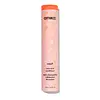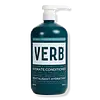What's inside
What's inside
 Key Ingredients
Key Ingredients

No key ingredients
 Benefits
Benefits

 Concerns
Concerns

 Ingredients Side-by-side
Ingredients Side-by-side

Water
Skin ConditioningCetearyl Alcohol
EmollientGlycerin
HumectantOlea Europaea Fruit Oil
MaskingDicetyldimonium Chloride
EmulsifyingBehentrimonium Methosulfate
Parfum
MaskingDivinyldimethicone/Dimethicone Copolymer
Hippophae Rhamnoides Seed Oil
Skin ProtectingGlycine Soja Oil
EmollientGlycine
BufferingAlanine
MaskingArginine
MaskingAspartic Acid
MaskingHistidine
HumectantIsoleucine
Skin ConditioningPhenylalanine
MaskingProline
Skin ConditioningSerine
MaskingThreonine
Valine
MaskingCetrimonium Chloride
AntimicrobialStearamidopropyl Dimethylamine
EmulsifyingPolyquaternium-37
Guar Hydroxypropyltrimonium Chloride
Skin ConditioningPhenoxyethanol
PreservativeSodium PCA
HumectantSodium Lactate
BufferingIsopropyl Alcohol
SolventPropylene Glycol Dicaprylate/Dicaprate
EmollientCaprylyl Glycol
EmollientPCA
HumectantCitric Acid
BufferingEthylhexylglycerin
Skin ConditioningPPG-1 Trideceth-6
Skin ConditioningHexylene Glycol
EmulsifyingC12-13 Pareth-3
EmulsifyingC12-13 Pareth-23
CleansingDisodium EDTA
Benzophenone-4
UV AbsorberButylphenyl Methylpropional
PerfumingHydroxycitronellal
PerfumingHydroxyisohexyl 3-Cyclohexene Carboxaldehyde
MaskingLimonene
PerfumingWater, Cetearyl Alcohol, Glycerin, Olea Europaea Fruit Oil, Dicetyldimonium Chloride, Behentrimonium Methosulfate, Parfum, Divinyldimethicone/Dimethicone Copolymer, Hippophae Rhamnoides Seed Oil, Glycine Soja Oil, Glycine, Alanine, Arginine, Aspartic Acid, Histidine, Isoleucine, Phenylalanine, Proline, Serine, Threonine, Valine, Cetrimonium Chloride, Stearamidopropyl Dimethylamine, Polyquaternium-37, Guar Hydroxypropyltrimonium Chloride, Phenoxyethanol, Sodium PCA, Sodium Lactate, Isopropyl Alcohol, Propylene Glycol Dicaprylate/Dicaprate, Caprylyl Glycol, PCA, Citric Acid, Ethylhexylglycerin, PPG-1 Trideceth-6, Hexylene Glycol, C12-13 Pareth-3, C12-13 Pareth-23, Disodium EDTA, Benzophenone-4, Butylphenyl Methylpropional, Hydroxycitronellal, Hydroxyisohexyl 3-Cyclohexene Carboxaldehyde, Limonene
Water
Skin ConditioningStearyl Alcohol
EmollientCetyl Alcohol
EmollientBehentrimonium Chloride
PreservativeBehentrimonium Methosulfate
Cetearyl Alcohol
EmollientIsopropyl Palmitate
EmollientPyrus Malus Fruit Extract
Skin ConditioningArgania Spinosa Kernel Oil
EmollientOrbignya Oleifera Seed Oil
EmollientCeramide NP
Skin ConditioningSqualane
EmollientEthylhexyl Olivate
Skin ConditioningPanthenol
Skin ConditioningEthylhexylglycerin
Skin ConditioningGlycerin
HumectantLauryl/Myristyl Polyricinoleate
EmollientC11-13 Isoparaffin
SolventPolyquaternium-37
Propylene Glycol Dicaprylate/Dicaprate
EmollientTrisodium Ethylenediamine Disuccinate
Guar Hydroxypropyltrimonium Chloride
Skin ConditioningCetrimonium Chloride
AntimicrobialSteartrimonium Chloride
PreservativePPG-1 Trideceth-6
Skin ConditioningCitric Acid
BufferingParfum
MaskingIsopropyl Alcohol
SolventMyristyl Alcohol
EmollientArachidyl Alcohol
EmollientSodium Benzoate
MaskingPhenoxyethanol
PreservativeBenzyl Salicylate
PerfumingWater, Stearyl Alcohol, Cetyl Alcohol, Behentrimonium Chloride, Behentrimonium Methosulfate, Cetearyl Alcohol, Isopropyl Palmitate, Pyrus Malus Fruit Extract, Argania Spinosa Kernel Oil, Orbignya Oleifera Seed Oil, Ceramide NP, Squalane, Ethylhexyl Olivate, Panthenol, Ethylhexylglycerin, Glycerin, Lauryl/Myristyl Polyricinoleate, C11-13 Isoparaffin, Polyquaternium-37, Propylene Glycol Dicaprylate/Dicaprate, Trisodium Ethylenediamine Disuccinate, Guar Hydroxypropyltrimonium Chloride, Cetrimonium Chloride, Steartrimonium Chloride, PPG-1 Trideceth-6, Citric Acid, Parfum, Isopropyl Alcohol, Myristyl Alcohol, Arachidyl Alcohol, Sodium Benzoate, Phenoxyethanol, Benzyl Salicylate
Ingredients Explained
These ingredients are found in both products.
Ingredients higher up in an ingredient list are typically present in a larger amount.
Behentrimonium Methosulfate is an ammonium salt. It is mainly used to prevent static in haircare products as a surfactant.
Surfactants have differing ends: one side is hydrophilic while the other end is hydrophobic.
Surfactants also help your cleansers remove pollutants more easily from the skin.
Learn more about Behentrimonium MethosulfateCetearyl alcohol is a mixture of two fatty alcohols: cetyl alcohol and stearyl alcohol. It is mainly used as an emulsifier. Emulsifiers help prevent the separation of oils and products. Due to its composition, it can also be used to thicken a product or help create foam.
Cetearyl alcohol is an emollient. Emollients help soothe and hydrate the skin by trapping moisture.
Studies show Cetearyl alcohol is non-toxic and non-irritating. The FDA allows products labeled "alcohol-free" to have fatty alcohols.
This ingredient is usually derived from plant oils such as palm, vegetable, or coconut oils. There is debate on whether this ingredient will cause acne.
Due to the fatty acid base, this ingredient may not be Malassezia folliculitis safe.
Learn more about Cetearyl AlcoholThis ingredient is a preservative, antimicrobial, and emulsifier. It is often used in cosmetics for its ability to cleanse, condition, and reduce static.
Cetrimonium chloride is a quaternary ammonium salt, meaning it has a water-soluble structure.
Citric Acid is an alpha hydroxy acid (AHA) naturally found in citrus fruits like oranges, lemons, and limes.
Like other AHAs, citric acid can exfoliate skin by breaking down the bonds that hold dead skin cells together. This helps reveal smoother and brighter skin underneath.
However, this exfoliating effect only happens at high concentrations (20%) which can be hard to find in cosmetic products.
Due to this, citric acid is usually included in small amounts as a pH adjuster. This helps keep products slightly more acidic and compatible with skin's natural pH.
In skincare formulas, citric acid can:
While it can provide some skin benefits, research shows lactic acid and glycolic acid are generally more effective and less irritating exfoliants.
Most citric acid used in skincare today is made by fermenting sugars (usually from molasses). This synthetic version is identical to the natural citrus form but easier to stabilize and use in formulations.
Read more about some other popular AHA's here:
Learn more about Citric AcidEthylhexylglycerin (we can't pronounce this either) is commonly used as a preservative and skin softener. It is derived from glyceryl.
You might see Ethylhexylglycerin often paired with other preservatives such as phenoxyethanol. Ethylhexylglycerin has been found to increase the effectiveness of these other preservatives.
Glycerin is already naturally found in your skin. It helps moisturize and protect your skin.
A study from 2016 found glycerin to be more effective as a humectant than AHAs and hyaluronic acid.
As a humectant, it helps the skin stay hydrated by pulling moisture to your skin. The low molecular weight of glycerin allows it to pull moisture into the deeper layers of your skin.
Hydrated skin improves your skin barrier; Your skin barrier helps protect against irritants and bacteria.
Glycerin has also been found to have antimicrobial and antiviral properties. Due to these properties, glycerin is often used in wound and burn treatments.
In cosmetics, glycerin is usually derived from plants such as soybean or palm. However, it can also be sourced from animals, such as tallow or animal fat.
This ingredient is organic, colorless, odorless, and non-toxic.
Glycerin is the name for this ingredient in American English. British English uses Glycerol/Glycerine.
Learn more about GlycerinThis ingredient is derived from guar gum.
It is a conditioning ingredient, meaning it helps soften skin and hair.
Isopropyl Alcohol is more commonly known as rubbing alcohol. It is most commonly used as a solvent, meaning it helps other ingredients dissolve.
This ingredient is an astringent alcohol. Astringent alcohols may also irritate skin as they high amounts may strip away your skin's natural oils.
Other types of astringent alcohols include:
According to the National Rosacea Society based in the US, you should be mindful of products with these alcohols in the top half of ingredients.
Any type of sanitizing product will have high amounts of alcohol to help kill bacteria and viruses.
Learn more about Isopropyl AlcoholParfum is a catch-all term for an ingredient or more that is used to give a scent to products.
Also called "fragrance", this ingredient can be a blend of hundreds of chemicals or plant oils. This means every product with "fragrance" or "parfum" in the ingredients list is a different mixture.
For instance, Habanolide is a proprietary trade name for a specific aroma chemical. When used as a fragrance ingredient in cosmetics, most aroma chemicals fall under the broad labeling category of “FRAGRANCE” or “PARFUM” according to EU and US regulations.
The term 'parfum' or 'fragrance' is not regulated in many countries. In many cases, it is up to the brand to define this term.
For instance, many brands choose to label themselves as "fragrance-free" because they are not using synthetic fragrances. However, their products may still contain ingredients such as essential oils that are considered a fragrance by INCI standards.
One example is Calendula flower extract. Calendula is an essential oil that still imparts a scent or 'fragrance'.
Depending on the blend, the ingredients in the mixture can cause allergies and sensitivities on the skin. Some ingredients that are known EU allergens include linalool and citronellol.
Parfum can also be used to mask or cover an unpleasant scent.
The bottom line is: not all fragrances/parfum/ingredients are created equally. If you are worried about fragrances, we recommend taking a closer look at an ingredient. And of course, we always recommend speaking with a professional.
Learn more about ParfumPhenoxyethanol is a preservative that has germicide, antimicrobial, and aromatic properties. Studies show that phenoxyethanol can prevent microbial growth. By itself, it has a scent that is similar to that of a rose.
It's often used in formulations along with Caprylyl Glycol to preserve the shelf life of products.
We don't have a description for Polyquaternium-37 yet.
We don't have a description for PPG-1 Trideceth-6 yet.
Propylene Glycol Dicaprylate/Dicaprate is a mixture of Propylene Glycol Dicaprylate and Propylene Glycol Dicaprate.
It is an emollient and helps hydate the skin.
Water. It's the most common cosmetic ingredient of all. You'll usually see it at the top of ingredient lists, meaning that it makes up the largest part of the product.
So why is it so popular? Water most often acts as a solvent - this means that it helps dissolve other ingredients into the formulation.
You'll also recognize water as that liquid we all need to stay alive. If you see this, drink a glass of water. Stay hydrated!
Learn more about Water